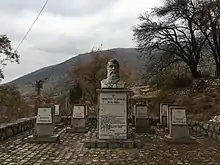Voivode Hristo Uzunov | |
|---|---|
 Hristo Uzunov c. 1900 | |
| Native name | Христо Узунов |
| Birth name | Христо Димитров Узунов |
| Born | 22 February 1878 Ohrid, Ottoman Empire (present-day North Macedonia) |
| Died | 24 April 1905 Cer, Ottoman Empire (present-day North Macedonia) |
| Buried | |
| Allegiance | |
| Years of service | 1896-1905 |
| Commands held | Ohrid Branch of the IMARO |
| Battles/wars | Ilinden Uprising Macedonian Struggle † |
| Alma mater | Bulgarian Men's High School of Thessaloniki |
| Other work | Teacher |
Hristo Dimitrov Uzunov (Bulgarian/Macedonian: Христо Димитров Узунов; 22 February 1878 – 24 April 1905) was a Macedonian Bulgarian teacher and revolutionary, head of the Ohrid branch of the Internal Macedonian Revolutionary Organization and its ideological leader in the Ohrid region.[1][2][3][4]
Revolutionary life

Uzunov was born in 1878 in Ohrid, then in Ottoman Empire. Both his father and mother were active in the Bulgarian national movement. After the establishment of the Principality of Bulgaria, his father moved to Sofia and worked as a librarian in the National Library. Uzunov became a member of the revolutionary movement in 1896, while he was studying in the Bulgarian Men's High School of Thessaloniki. Afterwards, he worked as a teacher in the Bulgarian Exarchate.[7] After the murder of Dimitar Grdanov, a Serbian teacher in Ohrid by Metody Patchev, Uzunov, along with Patchev, Kiril Parlichev and Ivan Grupchev were arrested.[8] Between January 1902 and March 1903 he was re-imprisoned in Bitola. He actively participated in the Ilinden Uprising in 1903. After Toma Davidov was killed in March 1903, Uzunov took over the leadership of the revolutionary organization in the Ohrid area.[9]

On 23 July 1903, in the village of Kuratica, near Ohrid, the flag of Uzunov's cheta was consecrated. The flag was handed over to Uzunov and with it the regional cheta. Uzunov, along with his cheta, participated in the Ilinden Uprising.[10] Between 1904 and 1905 he fought against Serbian guerrillas in Macedonia[11] and tried to resolve of the organization's internal problems.
Death

In 1905 Uzunov went to Bitola and Kičevo with his cheta in order to gain control of the region. On 23 April 1905, they entered the village of Cer together with Vancho Sarbakov. On the night of 24 April they were surrounded by Ottoman forces and after using all of their ammunition, they decided to commit suicide.[12] Prior to commiting suicide, Uzunov wrote a short letter addressed to all honourable revolutionaries.
He's buried in Cer, where he died.
References
- ↑ Радев, Симеон. Ранни спомени, Български писател, 1969, стр. 316.
- ↑ Трагичната участ на Узунова и четата му, Тома Николов, Отеч. фронт, София, 1989, гл. 16.
- ↑ Дневник на Христо Узунов (Memoires from Hristo Uzunov. The original was written in Bulgarian. The notes were made immediately after the Ilinden uprising for much of the winter of 1903, when Uzunov resided in Ohrid as illegal. In short, in chronological order, it traces the history of the Ohrid Revolutionary Organization from its inception in 1894 to the suppression of the uprising. Uzunov probably intended to write a story about the revolutionary movement in Ohrid. Some of the names and facts in the notebook are given with a cipher. They are decrypted by the voivode's brother - Angel Uzunov. All the pages in the notebook are not listed (p. 2, 6—94, 109, 115, 121—124, 130, 136—139). Table 2 consists of a list of killed Bulgarians (only) in Ohrid and Struga areas on suspicion of being IMRO activists.), в: "Дневници и спомени за Илинденско-Преображенското въстание", Издателство на Отечествения фронт, София, 1984, стр.83-147.
- ↑ Николов, Борис, Непубликувани документи из архива на Христо Узунов, сп. Исторически преглед, кн. 5, София, 1990, с. 81–91; Nikolov, Boris, Unpublished Documents from the Archive of Hristo Uzunov, Historical Review Magazine, Vol. 5, Sofia, 1990, pp. 81–91(in Bulgarian)
- ↑ National military history museum of Bulgaria, fond 260
- ↑ Илиев, Ив. Свети бойни реликви. — Военноисторически сборник, 1983, № 3, е. стр. 207—209.
- ↑ Historical Dictionary of the Republic of Macedonia, Dimitar Bechev, Scarecrow Press, 2009, ISBN 0810855658, p. 230.
- ↑ Makedonija (501-512 ed.). 1995. p. 30.
- ↑ Николов, Борис Й. Вътрешна македоно-одринска революционна организация. Войводи и ръководители (1893 – 1934). Биографично-библиографски справочник, София, 2001, стр. 40.
- ↑ Иванов Иван, Знамената на освободителното движение и въстанията в Македония и Тракия (откъс от "Български бойни знамена и флагове") Издателство на Министерство на отбраната "Св. Георги Победоносец", 1998.
- ↑ Николов, Тома. "Спомени от моето минало", Издателство на Отечествения фронт, София, 1989
- ↑ Трагичната участ на Узунова и четата му, Тома Николов, Отеч. фронт, София, 1989.